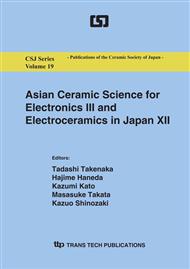p.251
p.255
p.259
p.263
p.269
p.273
p.277
p.281
p.285
Synthesis of Nano-Sized Barium Titanate Powder by Rotary-Hydrothermal Process
Abstract:
Nano-sized BaTiO3 powders with narrow size distribution and the high tetragonality were attempted to synthesize by the rotary-hydrothermal process in water system, using two kinds of commercial anatase-type TiO2 (ST21/ST01) with different particle size and Ba(OH)2. The rotary-hydrothermal syntheses were done with the rotary-speed of 20 revolutions per minute at 523 K for 24 h. Highly- and mono-dispersed BaTiO3 powders were successfully synthesized by applying the rotary-hydrothermal process. For rotary-hydrothermal synthesis, it was found that the average size, tetragonality, and quality of the BaTiO3 particle strongly depended on the particle size of the starting material. In the case of using ST01 as a starting material, BaTiO3 nano-powders mainly composed of coarse-faceted particles (average particle size = ca.100 nm) with the tetragonal phase and very little lattice defects were successfully synthesized.
Info:
Periodical:
Pages:
269-272
Citation:
Online since:
December 2009
Authors:
Price:
Сopyright:
© 2010 Trans Tech Publications Ltd. All Rights Reserved
Share:
Citation:


